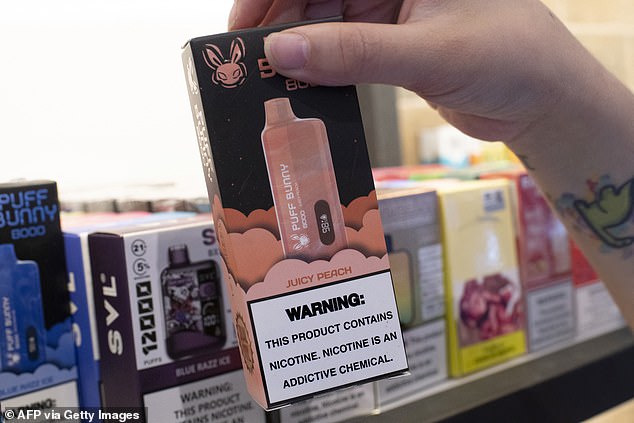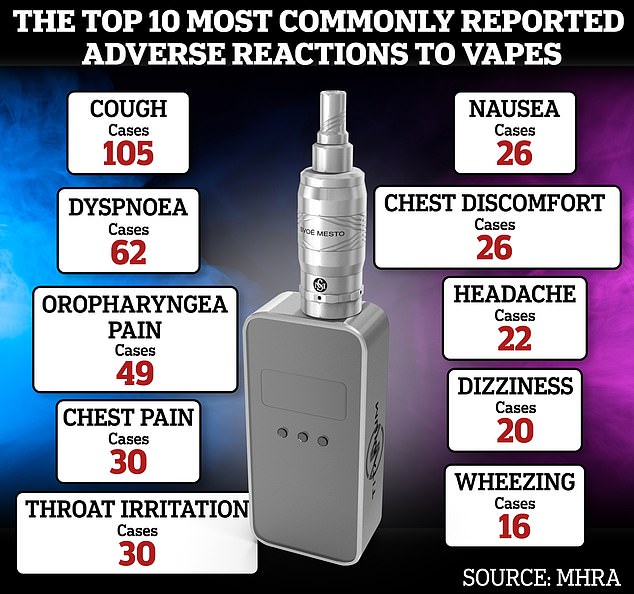Number of young adults vaping TRIPLES in two years: Shock data shows almost a third of 18 to 24 year olds have used e-cigarettes, as experts urge ministers to pass landmark Tobacco and Vaping Bill before election to sign
The number of young people vaping has tripled in two years, but the number of smokers continues to fall, a new study shows.
Researchers from University College London (UCL) say the use of disposable vapes among people aged 18 to 24 is driving the use of highly addictive nicotine in England.
And while experts said vaping is better than smoking, they warned they are not without risk and should not be used by people who have never smoked.
The study, funded by Cancer Research UK, looked at vaping and smoking data for 132,252 people in England from July 2016 to May 2023.
Researchers wanted to examine the changes in vaping and smoking before and after disposables became popular in June 2021.
Colorful candy-flavored disposable vapes are being marketed to young people and their use among this group has tripled in two years

Unregulated disposable vapes can be sold in candy stores, novelty stores and even toy stores

Vapes come in many different flavors, including this one in ‘juicy peach’
Disposable vapes are usually sold in clear packaging and come in a variety of flavors, including pineapple ice cream and cherry cola.
The research found that smoking and vaping in England were stable or declining across all age groups until June 2021.
“However, since disposable vaping products began to become popular, vaping has increased across all age groups – especially among younger adults (18 to 24 years old),” the report said.
The share of young people who said they vape tripled over the period, from nine percent in May 2021 to 29 percent in May 2023.
Smoking in this age group fell from 25 percent to 21 percent, but total nicotine use increased from 28 percent to 35 percent.
In older age groups, the prevalence of vaping rose from five percent to six percent among those over 45, while smoking also rose from 12 percent to 14 percent.
The increase in vaping was greatest among people who had never smoked: from two percent to nine percent among 18 to 24-year-olds.

Since February, a total of 1,009 reactions to vaping have been recorded by the Medicines and Healthcare products Regulatory Agency. Here are the 10 most common reports
Overall, the researchers said that after disposables became popular in 2021, the likelihood of people saying they vape increased by 99 percent per year among 18-to-24-year-olds, compared to 39 percent among 25-to-44-year-olds . and 23 percent in people aged 45 or older.
The team concluded: ‘Since disposable vapes began to become popular in England, the historic decline in nicotine use has been reversed.
‘Now nicotine use appears to be increasing, mainly driven by the strong increase in vaping among young people.
‘The decline in smoking rates is most pronounced across age groups, with the biggest increase in vaping.
‘Urgent action is needed to tackle the rise in disposable vaping among people who would otherwise avoid nicotine completely.
‘This could, for example, be an excise tax, a packaging restriction or placing fumes behind the counters.’
Lead author Dr Harry Tattan-Birch, from University College London (UCL), said: ‘The rapid rise in vaping would be less worrying if the number of smokers had fallen faster.
‘The overall increase in nicotine use shows that this has not happened.
‘Instead, driven by the advent of the highly popular disposable e-cigarettes, vaping has become much more common among young people, some of whom would otherwise likely have avoided nicotine entirely.
‘Given these findings, the UK Government’s current Tobacco and Vaping Act to reduce vaping among young people is welcome.’
Senior author Dr Sarah Jackson, also from UCL, said: ‘While action is needed to tackle the rise in vaping among young people who would not otherwise use nicotine, policy must avoid making e-cigarettes a worse alternative is for smoking tobacco.
‘Vaping may not be without risk, but smoking is deadly.
‘It is also crucial that policies designed to make e-cigarettes less attractive to young people do not inadvertently make these products less effective at helping people quit smoking.
‘Measures that focus on the appearance, packaging and marketing of vaping products rather than their flavors and nicotine content may be most effective in achieving this balance.’
Dr. Ian Walker, executive director of policy at Cancer Research UK, said: ‘This study shows a worrying increase in the number of young adults using vapes since disposables went on sale in Britain.
‘The evidence to date shows that vapes are much less harmful than cigarettes, but cannot be considered risk-free and certainly should not be placed in the hands of children or people who have never smoked.
‘A continued decline in smoking rates is encouraging to see, but we cannot become complacent; Smoking is still the biggest cause of cancer in Britain and it is vital that we protect the next generation from a lifetime of addiction.
“All parties must ensure that the landmark Tobacco and Vaping Bill is passed by Parliament before the government is dissolved ahead of a general election.”
The Tobacco and Vape Act would make it illegal to sell tobacco products to anyone born on or after January 1, 2009.
It also aims to reduce vaping among young people through stricter controls.
However, unless it is passed into law before parliament is dissolved ahead of the July 4 general election, it will be suspended until a new government is installed.
Both the Tories and Labor have said they will revive the bill if they come to power.
The vaping study was published in the journal Lancet Regional Health – Europe.
It comes as the World Health Organization (WHO) published a report saying vapes and other new tobacco and nicotine products “pose a serious threat to youth and tobacco control.”
Dr. Tedros Adhanom Ghebreyesus, Director-General of WHO, said: “History is repeating itself as the tobacco industry tries to sell the same nicotine in different packages to our children.
‘These industries are actively targeting schools, children and young people with new products that are essentially a candy-flavoured trap.
“How can they talk about harm reduction when they’re marketing these dangerous, highly addictive products to children?”
Dr. Ruediger Krech, WHO’s director of health promotion, said: “The use of child-friendly flavors such as cotton candy and bubble gum, combined with sleek and colorful designs that resemble toys, is a blatant attempt to addict young people to these harmful products.”
